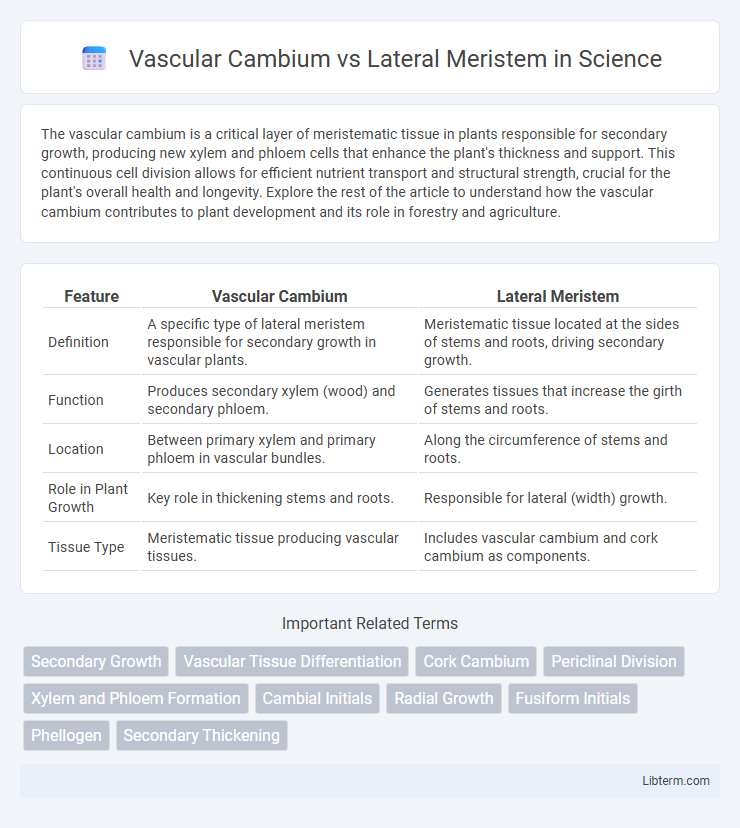The vascular cambium is a critical layer of meristematic tissue in plants responsible for secondary growth, producing new xylem and phloem cells that enhance the plant's thickness and support. This continuous cell division allows for efficient nutrient transport and structural strength, crucial for the plant's overall health and longevity. Explore the rest of the article to understand how the vascular cambium contributes to plant development and its role in forestry and agriculture.
Table of Comparison
| Feature | Vascular Cambium | Lateral Meristem |
|---|---|---|
| Definition | A specific type of lateral meristem responsible for secondary growth in vascular plants. | Meristematic tissue located at the sides of stems and roots, driving secondary growth. |
| Function | Produces secondary xylem (wood) and secondary phloem. | Generates tissues that increase the girth of stems and roots. |
| Location | Between primary xylem and primary phloem in vascular bundles. | Along the circumference of stems and roots. |
| Role in Plant Growth | Key role in thickening stems and roots. | Responsible for lateral (width) growth. |
| Tissue Type | Meristematic tissue producing vascular tissues. | Includes vascular cambium and cork cambium as components. |
Introduction to Plant Meristems
Vascular cambium is a specific type of lateral meristem responsible for producing secondary xylem and phloem, contributing to the thickening of stems and roots in woody plants. Lateral meristems, including the vascular cambium and cork cambium, are regions of active cell division enabling secondary growth. These meristematic tissues differ from apical meristems by facilitating increases in girth rather than length.
Overview of Vascular Cambium
Vascular cambium is a type of lateral meristem responsible for secondary growth in plants, producing secondary xylem (wood) inward and secondary phloem outward. This cylindrical layer of meristematic cells lies between the primary xylem and primary phloem in dicot stems and roots. Its activity increases stem thickness and facilitates nutrient and water transport throughout the plant.
Definition of Lateral Meristem
The lateral meristem is a type of plant tissue responsible for secondary growth, increasing the thickness of stems and roots by producing new layers of cells. Vascular cambium, a specific form of lateral meristem, generates secondary xylem and phloem for efficient water and nutrient transport. Unlike the general lateral meristem, which also includes the cork cambium, vascular cambium primarily contributes to the vascular system's expansion.
Structural Differences
Vascular cambium is a type of lateral meristem responsible for producing secondary xylem and phloem, characterized by a continuous cylinder of meristematic cells located between the primary xylem and phloem. The lateral meristem broadly includes vascular cambium and cork cambium, with the cork cambium forming the outer protective layer of bark, differing structurally as it generates periderm instead of vascular tissues. Vascular cambium cells are fusiform and ray initials that contribute to vascular tissue, while other lateral meristem cells vary in shape depending on their specific role in plant secondary growth.
Functions of Vascular Cambium
Vascular cambium primarily functions in secondary growth by producing secondary xylem (wood) inward and secondary phloem outward, facilitating the thickening of stems and roots. It plays a crucial role in the transport of water, nutrients, and photosynthetic products, enhancing structural support and nutrient distribution. Unlike lateral meristem, which includes both vascular cambium and cork cambium, vascular cambium specifically contributes to the vascular tissue formation essential for plant growth and regeneration.
Functions of Lateral Meristem
Lateral meristem is responsible for the secondary growth of plants, increasing the girth of stems and roots by producing secondary xylem (wood) and secondary phloem, which enhances structural support and nutrient transport. The vascular cambium, a type of lateral meristem, specifically generates secondary vascular tissues, while the cork cambium produces protective outer bark. The overall function of the lateral meristem is crucial for thickening organs and enabling plants to adapt to environmental stresses through continuous tissue regeneration.
Significance in Plant Growth
Vascular cambium is a type of lateral meristem responsible for secondary growth, producing secondary xylem and phloem that increase the thickness of stems and roots. Lateral meristems, including vascular cambium and cork cambium, contribute to the radial expansion of plants by adding new layers of cells. The activity of vascular cambium is crucial for enhancing the structural support and vascular transport capacity, enabling plants to grow taller and wider over time.
Key Similarities and Distinctions
Vascular cambium and lateral meristem are both types of meristematic tissue responsible for secondary growth in plants, contributing to increased girth. Vascular cambium specifically produces secondary xylem (wood) and secondary phloem, playing a key role in vascular tissue development, whereas lateral meristem broadly refers to all meristematic tissues that contribute to thickness, including both vascular cambium and cork cambium. The main distinction lies in function and location: vascular cambium is situated between the primary xylem and phloem, while lateral meristem encompasses all meristematic activities along the plant's lateral axis.
Role in Secondary Growth
Vascular cambium is a specific type of lateral meristem responsible for secondary growth by producing secondary xylem (wood) towards the inside and secondary phloem towards the outside, increasing the girth of stems and roots. Lateral meristems, which include vascular cambium and cork cambium, facilitate the thickening of plants by generating new tissues laterally rather than elongating the plant vertically. The vascular cambium's activity is crucial for the formation of wood and vascular tissues, while the broader lateral meristem category encompasses all secondary growth tissues contributing to plant structural support and nutrient transport.
Importance in Plant Adaptation
Vascular cambium, a type of lateral meristem, plays a crucial role in plant adaptation by enabling secondary growth and thickening of stems and roots, which supports increased water and nutrient transport. Lateral meristems, including vascular cambium and cork cambium, contribute to the plant's structural stability and protective outer layers, enhancing survival in diverse environmental conditions. This adaptation allows woody plants to expand their girth and improve resilience against mechanical stress and environmental challenges.
Vascular Cambium Infographic

 libterm.com
libterm.com